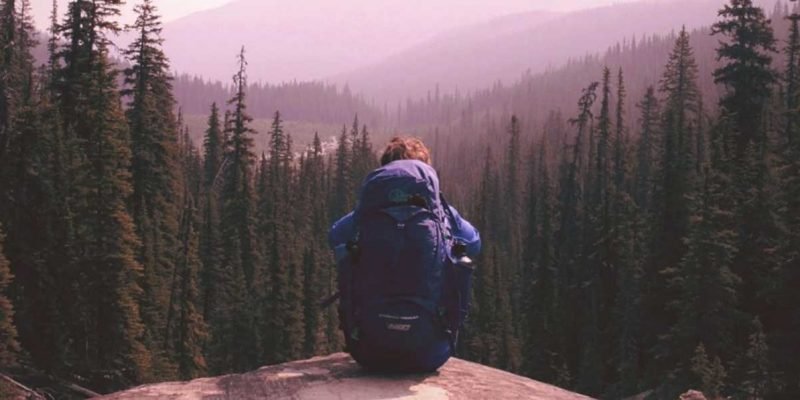When choosing a backpack for hiking, it’s very important to know your torso length, and the type of hiker you are. Where you will hike, the amount of time you will be hiking, and even the pace you want to hike should be considered. Will you be going on a thru-hike, a day hike? Once you answer these questions, finding a backpack that fits your hiking needs will be a lot more straightforward.
Your current gear dictates your pack
Before investing in a backpack, evaluate the gear you currently have. Your sleeping and shelter gear will largely influence the backpack size you decide to purchase. If you have heavy outdated gear then you will need a bigger backpack to store that gear. Now you may want to invest in better gear before investing in a backpack, that way you won’t need such a bulky backpack.
Next, discriminate between essential and luxury items only bringing one or two luxury items if you want to save weight. Once your weight shrinks, so does the size of your backpack.
After you have done these preliminary steps, know the answers to these questions. Where will you hike, what will you do, and for how long?
Where and for how long?
If you will be hiking for three days on a rocky trail in the desert, then water is a priority. You want a pack that will have both stability and capacity for carrying a large load of water.
Going thru-hiking, you’ll need something super lightweight, that is when you get into ultralight backpacking territory which is for more experienced hikers.
Winter camping: You will sweat due to humidity, so get a well-ventilated pack. Camping in winter means storing heavier gear, which means you’ll need a heavier backpack for storing that gear.
What type of backpacker are you?
Knowing the type of backpacker you are will make selecting a pack easier. Which options are a priority for you? Remember that each backpack has its trade-offs since a backpack cannot be ultralight and store heavy gear.
Convenience: If Quickness is a priority, avoid features with open lid access. If you want to quickly access your sleeping bag during a storm then your gear would get wet from unloading it all to reach your bag at the bottom. Find a pack with bottom or side zipper access enabling you to reach this gear in a pinch. You can also easily grab a coat in case you get cold/wet with packs designed for convenience.
Weight conscience: Do you enjoy putting your body to the test and find joy in completing big miles every day? Want to move swiftly through the woods, and lessen your burden from unnecessary items? Then an ultralight backpack could be the best option for you.
Luxury camper: Do you want to have a comfortable camp set-up, and some luxury items to occupy your time like a book or camera? Do you want to stroll down the trail at a comfortable pace, and make multiple stops to snack and enjoy the view? Then you could use a bigger pack with plenty of space.
Odd cargo: What backpack is good for a bigger load? (think oversize tents or inflatable kayaks). External-frame packs are what you’re looking for and also they offer good ventilation and lots of gear organization options.
Day hiking pack: A 30-liter pack can carry all of your essentials, including snacks, water, and a raincoat or other extra clothing.
Types of backpacks
I will go over the features and benefits different backpacks tend to have based on the type of pack.
Internal frame backpacks are the standard nowadays instead of external frames because they are lighter, composed of carbon fiber and tough plastic. The frames won’t get caught on anything or anybody with an internal pack. Also, internal frames have hidden support rods and frames built into the backpack.
External frame packs can achieve a higher center of gravity, causing you to walk much straighter and upright giving them a very different feel from internal frame packs.
Women’s Packs: Features include smaller torso lengths and narrower shoulder widths than men’s packs. Waist belts and shoulder straps are curved making them fit better for most women’s body types.
Backpacking packs: These packs carry heavy loads (30-50 pounds) for several days and typically range between 50-80 liters in capacity. They have an internal frame, suspension, and several adjustment points. The main adjustment points include the hip belt, shoulder straps, sternum straps, compression straps, and load lifters. There are compartments for certain types of gear like sleeping bags, and straps to attach a sleeping pad to the outside. There are multiple slots on the sides so you can choose your preferred water-storing method.
Ultralight backpacks have fewer organizational options, and they usually use thinner, less durable materials. Also, these types of packs tend to be frameless, which means back support is provided by slipping in a sleeping pad.
Make sure the backpack fits you
The sizes-small, medium, and large refer to your torso, and the torso is the most important measurement to know before purchasing a pack. Also, backpacks should list the torso size in inches. Generally, below 18 inches is small, above 22 inches large, at 18-22 inches medium. (check before you buy, this info may vary depending on the manufacturer). You can get yourself measured at an outdoor store, or have help from a friend.
How to measure your torso:
Look down and find your seventh cervical vertebrae. While looking down touch the top of your neck and go down. Pass the first and second bump until you feel the third hard bump at the bottom of your neck where it meets your shoulders. Have a friend measure these vertebrae down to your iliac crest. Rub-down the side of your ribs past your side belly and then you should reach a hard bone, that’s your iliac crest. Measure the distance between your seventh cervical vertebrae and iliac crest. You could use a string or ribbon, mark that distance with a marker, then measure the ribbon with a tape measure. That’s how you find your torso length.
Also, consider your hip length when buying a backpack. Your backpack hip belt should not rest where your belt is but on top of your hips. Also, consider your shoulders, are they broad or small? Do you have wider hips? One more thing to consider, you could lose some weight so make sure your backpack can fit your waist a few inches smaller as well.
What to look for in a backpack
The price depends on the quality of material, the size, the brand, and the pack’s features. If it’s a bigger high name brand with multiple features and good material, then that pack will be more money.
- Waist belts: These belts prevent loads from continually tapping against your back, and they are standard among hiking backpacks. 80% of your weight should be centered around your hips. Without them, your body tilts back and the weight transfers unequally to your shoulders resulting in sore shoulders. Any pack with load-support technologies which transfer the load to the wearer’s hips helps for navigating uneven ground, and your comfort overall.
- Good material: Bungee or elastic cords should be thick, straps should be thick nylon webbing and clips should be durable heavy plastic. A pack with single-piece material made of nylon is ideal because nylon resists tearing better than cotton or polyester. Polyester is second, just remember the higher the value denier, the stronger and heavier your fabric will be. Make sure the bottom of the pack is made of a high-denier fabric to prevent punctures.
- Adjustable suspension, which can be adjusted to fit your torso, this is helpful if you’re between sizes.
- Compartments: Compartments are handy for separating dirty and clean clothes, or storing used toilet paper from the rest of your gear. Although having many compartments works best for people who like having their gear organized.
- Ventilation: Padded backs can make your back sweat unless they have air-mesh foam. Contour lines help air circulate via a middle gap between two foam pads. Also external frames allow for airflow between your body and the pack, that way your back won’t get as sweaty. Lumbar shaped packs create a small space between your back and the bag which reduces sweat.
- Load lifter straps: People often overlook these straps, but they are very important for stabilizing your pack. These straps stop your body from pulling you backward, instead, the weight gets shifted towards your hips and shoulders. Don’t pull too hard on these though, pull gently on them.
- Frameset: Backpacks typically use both a frame sheet and aluminum stays to provide support. These frames give backpacks their shape and help packs with weight distribution.
- Gold aluminum bar: This will be inside the pack, it runs along the spine providing helpful support.
- Aluminum stays: Stays are thin support rods that go along the length of your pack giving it stiffness and shape. Sometimes they are found down the center and on the sides of backpacks.
Semi-waterproof material/rain covering: Most backpacks come with rain covers, and waterproof material will help you because the weather can always change.
- Beginner: Typically 50-65 liter, but don’t buy too big of a pack if you’re a beginner.
- Elasticized side pockets look flat while empty but they can stretch out to hold a water bottle, tent poles, or other loose objects.
Outro
Now I would recommend renting or borrowing a few different packs from a friend to find what feels right. Go on a few day hikes with your pack and notice any uncomfortable spots, then switch your pack until you find a comfortable one. You should aim to spend between $100–250 USD on your backpack.
(Author bio)
Ryan Pratschner is the founder and writer at outsideboogie.com. We cover many topics, from camping and hiking to backpacking and more. Let us research so you can start packing and go boogie!
Whether it be reviews or answers to questions about outdoor gear and resources, you will find it here at outsideboogie.com















Comments